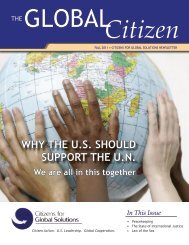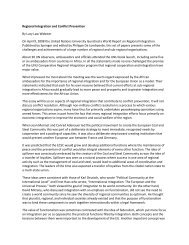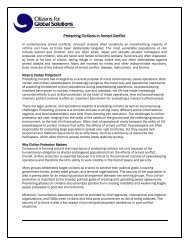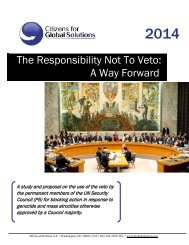Minerva, Spring 2008 (Volume 32) - Citizens for Global Solutions
Minerva, Spring 2008 (Volume 32) - Citizens for Global Solutions
Minerva, Spring 2008 (Volume 32) - Citizens for Global Solutions
Create successful ePaper yourself
Turn your PDF publications into a flip-book with our unique Google optimized e-Paper software.
tation. Some are concerned that the responsibility to protect will be defined too narrowly,<br />
as a doctrine <strong>for</strong> military intervention. Conversely, others feel that the concept<br />
is too vague to be particularly useful as an advocacy tool and are unclear about how<br />
to promote its implementation. Valid questions have been raised about which conflicts<br />
it should be applied to and, if applied, the range of measures to invoke – from early<br />
preventive action to military intervention. Advocacy groups have expressed confusion<br />
over whether to use the responsibility to protect as an advocacy tool in relation to specific<br />
conflicts, or whether they should promote the concept in and of itself. Amid the<br />
confusion, Darfur provides a constant reminder of the substantial gap between agreed<br />
concepts of civilian protection and the capacity and will to implement them.<br />
ACTORS AND PROCESSES: From Articulation to Implementation<br />
The United Nations<br />
The United Nations has a lead role to play in implementing the responsibility to protect.<br />
In 1999, Kofi Annan warned that “if the collective conscience of humanity . . .<br />
cannot find in the United Nations its greatest tribune, there is grave danger that it will<br />
look elsewhere <strong>for</strong> peace and <strong>for</strong> justice”. 17 It seems this warning is slowly but surely<br />
being heeded. For example, in May 2007, Ban Ki-moon strengthened and expanded<br />
the mandate of the Special Adviser on the Prevention of Genocide. 18 In early <strong>2008</strong>, a<br />
second Special Advisor was appointed to focus primarily on developing consensus<br />
around the Responsibility to Protect.<br />
Implementing the responsibility to protect, however, cannot be limited to one office – it<br />
will require ef<strong>for</strong>ts across the system, particularly the Office of the High Commissioner<br />
<strong>for</strong> Human Rights, the Department of Peacekeeping Operations (DPKO) and the Office<br />
<strong>for</strong> the Coordination of Humanitarian Affairs (OCHA). There have been positive<br />
signals that the responsibility to protect is taking hold in these and other parts of the<br />
system. The High Commissioner <strong>for</strong> Human Rights, Louise Arbour, has been a vocal<br />
advocate <strong>for</strong> the responsibility to protect. OCHA appears to be slowly but surely incorporating<br />
elements of the responsibility to protect into its broader work programme<br />
on the protection of civilians in armed conflict. DPKO lessons-learned exercises and<br />
the development of doctrine <strong>for</strong> peace operations are positive developments. In early<br />
2007, a Human Rights Council high-level mission on Darfur used the responsibility<br />
to protect as an organizing framework <strong>for</strong> its analysis of the human rights situation<br />
in the region. 19 The establishment of a new Peacebuilding Commission and ef<strong>for</strong>ts to<br />
strengthen the UN’s conflict prevention mechanisms 20 also contribute to the ability to<br />
move the preventive and reconstructive dimension of the responsibility to protect from<br />
concept to reality.<br />
Regional/Multilateral Organizations<br />
Footnotes 17–20:<br />
17 Kofi Annan, Address to the UN General<br />
Assembly (New York: 20 September<br />
1999)<br />
18 Juan Mendez held the part-time<br />
position of Special Adviser on the Prevention<br />
of Genocide from 2004-2007.<br />
Throughout 2006, a Special Advisory<br />
Committee developed recommendations<br />
<strong>for</strong> strengthening the office. It was subsequently<br />
upgraded to a full-time position.<br />
Francis Deng was appointed to this post<br />
in May 2006.<br />
19 Report of the High-Level Mission on<br />
the situation of human rights in Darfur<br />
pursuant to Human Rights Council<br />
decision S-4/101, A/HRC/4/80 (Geneva:<br />
Human Rights Council, 7 March 2007)<br />
20 See “Security Council Calls <strong>for</strong><br />
Boosting UN’s Role in Preventing,<br />
Resolving Conflicts” (New York: United<br />
Nations News, 28 August 2007)<br />
Leadership <strong>for</strong> implementing the responsibility to protect begins with the United Nations,<br />
but it does not end there. The role of multilateral organizations other than the UN<br />
should not be underestimated, both in strengthening international commitment to the<br />
concept as well as in implementation.<br />
The European Union, <strong>for</strong> example, expressed explicit support <strong>for</strong> embracing and upholding<br />
the responsibility to protect at a crucial point in the debates leading up to the<br />
2005 World Summit. The EU continues to support the implementation of the concept at<br />
a rhetorical level, yet there is little indication that either the Human Rights Council or<br />
the Peacebuilding Commission is working to incorporate the responsibility to protect<br />
into its programme of activities. A proposal <strong>for</strong> establishing an international centre<br />
<strong>for</strong> the prevention of genocide, championed by Javier Solana, Europe’s top official in<br />
international affairs, may be a positive development in this regard.<br />
17 • <strong>Minerva</strong> #<strong>32</strong> • June <strong>2008</strong>













